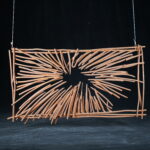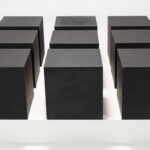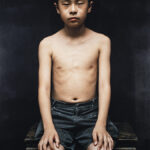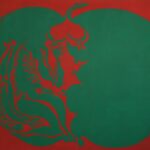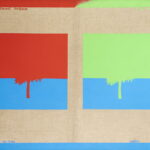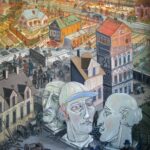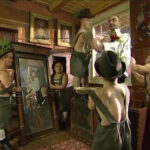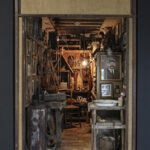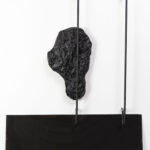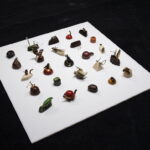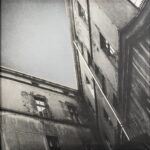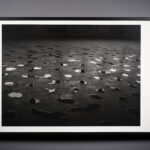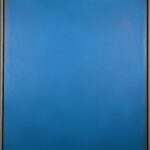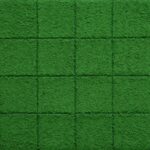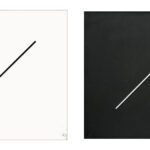Collection of Galeria Labirynt
Work is underway to transfer the collection to our website – more information about the collection as well as about artists is available on the archive page.
The art collection of the Galeria Labirynt in Lublin is a significant phenomenon among the collections created in Poland from the second half of the 20th century, which started collecting works of contemporary art of neo-avant-garde. The harvest begins at the turn of the 1960s and 1970s and associated with the activities of the Bureau of Artistic Exhibitions established in Lublin in 1956. At that time, the attention of buyers to the collection focused mostly on the achievements of artists operating in the country, although the gallery also implemented an international exchange programme.
The next stage, carried out in the years 1981–2009, was based on the author’s programme of Galeria Labirynt LDK (1974–1981) and defined the profile of the collection in line with the artistic programme of Galeria Labirynt operating within the structure of the Bureau of Artistic Exhibitions (BWA) in Lublin. The leading assumption of its programme at that time was the presentation of art that grew out of the tradition of two currents: conceptualism (conceptual art) and constructivism. The value of the collection, created in parallel with the image of art of that time and the extremely intense programme of the gallery, was the neo-avant-garde heritage and contemporary art.
Since 2010, the art collection programme results from the concept of the new artistic programme of Galeria Labirynt, which in part refers to the community of the neo-avant-garde tradition, with an emphasis on performance art, and at the same time presents examples of post-postmodern updates of critical art and extends the program with the presentation (promotion) of art young generation of Polish and foreign artists, including artists from Ukraine and Israel.
The collection of contemporary art of Galeria Labirynt in Lublin, with its many years of history, shows the image of an ideologically dynamic era from the second half of the 20th century and the beginning of the 21st century, characterised by the clash of concepts and attitudes. The foundation was the legacy of what successive avant-garde had left behind. At the same time, it is no less important to observe the phenomena that have been taking place in the newest art since the beginning of the 21st century. The collection of contemporary art is a collection of ideas, manifestos, attitudes, mental and formal experiments contained in the tissue of language and forms expressing themselves in the following genres: painting, drawing, graphics, objects, installations, sculpture, photography, video. The collection is international in nature, as it consists of works by Polish and foreign artists from different continents.
Beginning with the oldest examples, an important place in the collection is occupied by experimental works by innovative artists from the Lublin Grupa Zamek (1956–1960), introducing ideas of new art, ground-breaking for the concept of an image liberated from the status of an aesthetic object – present in the works of Jan Ziemski and in the compositions of Krzysztof Kurzątkowski. The collection mainly reflects the trends visible from the beginning of the 1970s, leading in creating artistic attitudes and statements, born through research and experiment, on the basis of the exchange of experiences with Western art, in the then politically difficult times. These include the action art, demonstration, and performance art trend present in the works by Włodzimierz Borowski, Zbigniew Warpechowski, Krzysztof Zarębski, Jerzy Bereś, Jan Świdziński, Anna Kutera and Romuald Kutera. An important place in the collection is art from the field of experiences of photo-mediaism, film and video, analysing the language of these media, studying the phenomena of reality and art using new media, represented by: Natalia LL, Andrzej Lachowicz (founders of the Permafo Gallery), Józef Robakowski and the artists of “Warsztat Formy Filmowej”, Zygmunt Rytka, Lucjan Demidowski, as well as the pioneers of the critical art – Andrzej Partum, Zofia Kulik and Przemysław Kwiek as well as Leszek Przyjemski and Anastazy B. Wiśniewski. An interesting example of the concept of “photosynthetic” photography are the works of Krzysztof Pruszkowski, faithful to the attitude that art does not create things but ideas. A conceptual approach to an artwork as a grammar of form, language and sign is presented in the works of Kajetan Sosnowski, Andrzej Dłużniewski, and Elżbieta Kalinowska. Andrzej Partum’s “Pulsation” seems to be significant for the collection, as the Galeria Labirynt was the main place for his philosophical peripatisation, announcing uncompromising manifestos and intellectually provocative performances.
An important part of the collection are artworks from the concrete poetry, represented by artists from the international Logomotives Group (1963–1983), which included Eugenio Miccini, Sarenco, Arias Misson, Julien Blaine, Jean-Francois Bory, and Paul De Vree. The basic motive and material for reflection in the semantic and graphic area was for them the word. First, they expressed themselves in concrete poetry, and then in visual and sound poetry, publishing magazines, books, CD recordings, creating inscriptions on walls, collages, and drawings.
Starting from the 1980s based on conceptual inventions (A. Kostołowski) and minimal art, more or less directly, works by Mikołaj Smoczyński, photographs of performances and objects by Zdzisław Kwiatkowski or Jerzy Truszkowski, emphasising the freedom and autonomy of art and the artist, and using a new language the statements, despite the announcement of the end of art (after conceptualism), continued to reformulate the space of the contemporary iconosphere.
Painting of the New Expression, undertaken by artists of the young generation of the 1980s, especially in the wording of the members of the “Gruppa” (Jarosław Modzelewski, Ryszard Grzyb, Włodzimierz Pawlak, Ryszard Woźniak, Paweł Kowalewski, Marek Sobczyk), whose second exhibition took place in Lublin in 1982 was a novelty in profiling the Collection, unless we take into account the programmatic announcement of participation in what in art should be considered a “new phenomenon”. Now, in confrontation with Nowa Figuracja (Jan Łazorek), a decade earlier than Neue Wilde Malerei, or critical naïve realism expressed in Edward Dwurnik’s painting from the 1970s, one can see a cyclical break with cool, analytical art, conceptualizing with the emergence of emotional and critical outbreaks, whose postmodern mixing dominates especially at the turn of the 20th and 21st centuries. The works of Jan Dobkowski, who in the 1970s eagerly referred to op-art, pop-art, and advertising graphics, should also be recalled.
The Galeria BWA in Lublin has often organised exhibitions of its own art collection, either problem-specific or due to the presentation of contemporary art attitudes and artistic directions, as well as on the occasion of the jubilee of the gallery’s programme. Until 2010, there were several dozen exhibitions of the collection, mentioning, for example, one of the first: “The 20th anniversary of the Galeria Labirynt art programme” from 1994 and one of the last: “Past Time – Present Time. BWA galleries in Lublin 1956–2006”. In 2010, the largest exhibition of the art collection to date was organised, entitled “Zakręty awangardy” (Bends of the Avant-garde), which at the same time started another stage resulting from the new programme of the Galeria Labirynt.
Jolanta Męderowicz

Loans of artworks from the collection of Galeria Labirynt in Lublin
Galeria Labirynt in Lublin may lend works of art from its own collection for exhibitions and expositions in Poland and abroad. Loan requests should be officially submitted to the Acting Director of Galeria Labirynt by post or e-mail no less than three months before the exhibition opening date. A loan request should contain the following information: list of artworks concerned; time period for which the loan is requested; place of the exhibition; title of the exhibition and basic information about it; opening and closing days of the exhibition; contact details of the organiser and persons responsible for the organisation of the loan (e-mail, address, phone number); data for the Loan Agreement: full name of the organiser, address and names of the persons authorised by the Borrower to sign Loan Agreements.
The decision to lend an artwork is made by the Acting Director of Galeria Labirynt on the basis of an opinion on its conservation status. The decision also depends on: exhibition plans at Galeria Labirynt in Lublin, the date and order of submitting of the loan request, transport safety, climatic conditions at the place of exhibition as well as the rank of the exhibition for which the loan is requested.
The Borrower is obliged to secure the appropriate conditions and costs connected with the loan of artworks, including the costs of a specialised transport company and the costs of insurance of the artworks for the time of transportation and at the place of the exhibition (“nail to nail” basis).
Approved decision to lend the works is confirmed by a written Loan Agreement drawn up in two identical copies. A signed copy of the Agreement should be submitted at Galeria Labirynt in Lublin one month before the planned loan, while the date and details concerning the reception of the works should be agreed at least two weeks beforehand.


